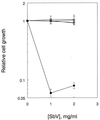Stage-specific activity of pentavalent antimony against Leishmania donovani axenic amastigotes
- PMID: 9925518
- PMCID: PMC89063
- DOI: 10.1128/AAC.43.2.278
Stage-specific activity of pentavalent antimony against Leishmania donovani axenic amastigotes
Abstract
The standard treatment of human visceral leishmaniasis involves the use of pentavalent antimony (SbV) compounds. In recent years increasing numbers of clinical failures of treatment with SbV have been reported, probably due to the development of parasite resistance to this compound. The mode of action and mechanisms of resistance to SbV have not been fully elucidated. In the present study an axenic amastigote culture was used to study the in vitro responses of Leishmania donovani to SbV. Susceptibility to both sodium stibogluconate and meglumine antimoniate was found to be stage specific. Amastigotes were 73 to 271 times more susceptible to SbV than were promastigotes. As opposed to SbV, trivalent antimony (SbIII) was similarly toxic to both developmental stages. When promastigotes were transformed to amastigotes, susceptibility to meglumine antimoniate developed after 4 to 5 days, upon the completion of differentiation. In contrast, with transformation from amastigotes to promastigotes, resistance to meglumine antimoniate was acquired rapidly, within 24 h, before the completion of differentiation. The culture of promastigotes at an acidic pH (5.5) or at an elevated temperature (37 degrees C) alone did not lead to the appearance of SbV susceptibility, emphasizing the requirement of both these environmental factors for the development of SbV susceptibility. A previously isolated sodium stibogluconate (Pentostam)-resistant L. donovani mutant (Ld1S.20) is also resistant to meglumine antimoniate, indicating cross-resistance to SbV-containing compounds. In contrast, no cross-resistance was found with SbIII, suggesting a mechanism of SbV resistance different from that described in Leishmania tarentolae. These data show that L. donovani susceptibility to SbV is parasite intrinsic, stage specific, and macrophage independent.
Figures





References
-
- Bates P A. Complete developmental cycle of Leishmania mexicana in axenic culture. Parasitology. 1994;108:1–9. - PubMed
-
- Bates P A, Robertson C D, Tetley L, Coombs G H. Axenic cultivation and characterization of Leishmania mexicana amastigote-like forms. Parasitology. 1992;105:193–202. - PubMed
-
- Berman J D, Chulay J D, Hendricks L D, Oster C N. Susceptibility of clinically sensitive and resistant Leishmania to pentavalent antimony in vitro. Am J Trop Med Hyg. 1982;31:459–465. - PubMed
-
- Borst P, Ouellette M. New mechanisms of drug resistance in parasitic protozoa. Annu Rev Microbiol. 1995;49:427–460. - PubMed
Publication types
MeSH terms
Substances
LinkOut - more resources
Full Text Sources
Research Materials

